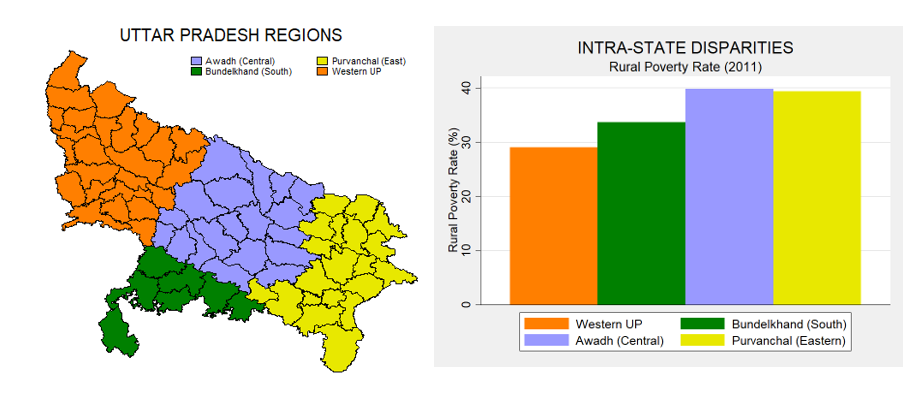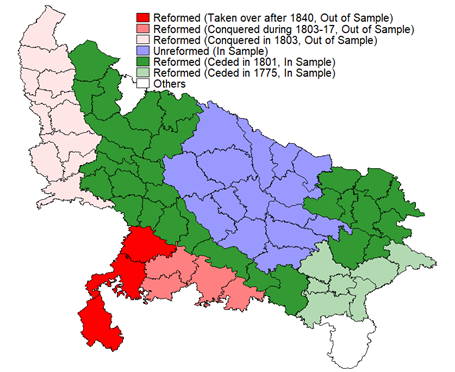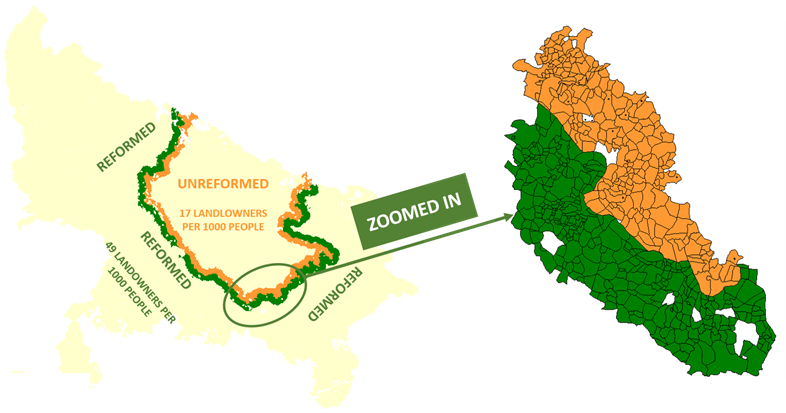Uttar Pradesh is characterised by significant intra-state variation in developmental outcomes, with research suggesting that this could be partially attributable to the long-run effects of differences in colonial land policies within the state. Comparing areas that underwent land reforms in the 19th century with those that did not, this article demonstrates that the former experienced positive long-run effects on wealth and human capital – including among lower-caste households whose ancestors did not receive land under the reforms.
India’s most populous state, Uttar Pradesh (UP), is home to over 200 million people. If it were an independent country, it would easily slot in among the top 10 countries by population. However, it is one of the country’s poorest states, with significant intra-state variation in developmental outcomes. While western UP has benefitted from the Green Revolution – a period of agricultural transformation – the parched southern region remains entrenched in feudalism. The central part of the state – home to the capital city of Lucknow – has the highest poverty rate, whereas eastern UP is well-known for complicated social (caste) dynamics. Almost 80 years after independence, and a slew of state-wide welfare policies, factors responsible for this intra-state variation constitute an important research question.
Figure 1. Intra-state disparities in poverty in Uttar Pradesh
Historical context: British colonial policy
A lot has been written about the long-run effects of landowning patterns on socioeconomic development. In the Indian context, cross-state studies have documented the persistent impact of colonial land tenure systems on agricultural outcomes and public good provision (Banerjee and Iyer 2005, Banerjee et al. 2005, Pandey 2010). Hence, there is strong reason to believe that at least a part of the heterogeneity within UP can be attributed to different colonial land policies. When the British East India Company (EIC) annexed a large part of UP (roughly 72% of the landmass) during the late 18th and early 19th century, they came into possession of an agrarian society. In large parts of the territory, land was under the control of powerful revenue farmers, who usually belonged to the upper echelons of the caste hierarchy. As a result, proprietary rights of indigenous rural communities were barely recognised.
During the first half of the 19th century, due to ideological changes within the British administration, the EIC sidelined these revenue farmers, and set out to award land ownership titles to communities who were the original landowners. Beginning in 1822, they started assessing proprietary claims of local communities across areas under their control. Subsequently, they granted land titles to village bodies whose claims were recognised. Compared to the portion of the state that remained out of the EIC’s control, the process led to the creation of a much bigger group of landowners. The said village bodies could be in the form of an individual/family, a body of co-owners linked by ancestry (Pattidari), or a body of co-owners not linked by ancestry who divided the land amongst themselves (Bhaichara). Yet, like the revenue farmers, a majority of these new landowners belonged to upper castes.
The EIC annexed the remainder of the state (central UP) during the 1850s. Despite their intention to implement a similar redistribution programme in this area, they could not do so owing to a national mutiny in 1857. In order to secure the political loyalty of revenue farmers in this region, the British authorities decided to grant proprietary titles to them. This policy led to a significant difference in land concentration within the state. For instance, as per data from the 1940s, the number of landowners per 1,000 people in reformed areas was 49 – almost thrice the number in the unreformed areas. As shown in the figure below, this policy provides a setup to estimate the long-run effects of land redistribution within the state.
Figure 2. Timing and implementation of land-ownership reforms across territories
Existing literature
The literature on the long-run effects of land concentration can be broadly categorised into two strands. On the one hand, it has been documented that lower levels of land concentration promote the evolution of institutions, which are more conducive for overall economic development (Engerman and Sokoloff 1997). On the other hand, it has also been shown that in settings with weak institutional frameworks, large landowners can aid in development by insulating landless non-elites from the potential negative effects of policies implemented by other stakeholders such as the political elite (Acemoglu et al. 2008, Dell 2010).
In the Indian context, the long-run effects of different colonial land policies on agricultural outcomes and public goods have been estimated using inter-state variation (Banerjee and Iyer 2005, Banerjee et al. 2008). However, there is limited evidence based on intra-state variation, which provides a better setup for such an exercise (Pandey 2010). While focusing on one state reduces the generalisability of results, it allays concerns regarding heterogeneity in other causal factors that may vary across states (such as differences in governance and climatic conditions). In addition, there has been relatively little discussion on potential channels of persistence, likely because policies enacted two centuries ago may have affected almost everything over time, making it challenging to identify specific mechanisms.
The study
Using the setup provided by the colonial policy in UP, I estimate the long-run effects of land redistribution on three different socioeconomic outcomes: durable asset ownership among households (Population Census, 2011), non-farm employment (Economic Census, 2013), and average years of schooling (Socio-Economic Caste Census, 2011). In particular, I compare villages within a very narrow radius (10 kilometres) around the boundary that separated the reformed and unreformed regions. This is desirable, for it is reasonable to assume that villages within such a narrow radius are similar along all relevant dimensions that impact long-run socioeconomic development, except the implementation of land redistribution.1
Figure 3. Villages within a 10-kilometre radius of the boundary
Contributing to the literature, I go beyond reporting the aggregate impact of land redistribution. Using granular caste-wise data, I estimate the effect of redistribution separately for caste groups that belong to the bottom of the hierarchy (Scheduled Castes (SC) and Scheduled Tribes (ST), although the former are of primary importance here, given the negligible tribal population in the state). This distinction is important as these groups did not receive any land under the colonial redistribution policy, which implies that any impact on them flows through indirect channels. Finally, while acknowledging that the identification of all channels of persistence is not feasible, using survey data collected during 2022, I explore the impact of land redistribution on long-run outcomes for lower-caste groups through changes to the implementation of the caste system.2 This is a novel contribution to existing literature on colonial land policies in India.
Empirical findings
Consistent with the literature on the negative long-run effects of land concentration, my results suggest that, when compared to villages within a 10-kilometre radius on the unreformed side of the border, those on the reformed side (within the same radius) have benefitted due to land redistribution. I find positive long-run effects of redistribution on durable asset ownership (by 6%), non-farm employment (by 50%), and average years of schooling (by 6%). These results pass standard robustness checks, including the inclusion of pre-19th century variables that I compile from the Ain-i-Akbari, a 16th century document.
Notably, SC households process have also benefited in the long run. This is interesting, because their ancestors did not receive any land during redistribution. Owing to the redistribution policy, when compared to unreformed areas, durable asset ownership among such households across reformed areas is higher by 12%, ownership of non-farm establishments is higher by 86%, and average years of schooling are higher by 6%.3,4
Land redistribution and caste system: Potential channel of persistence?
Owing to the historical nature of the redistribution policy, it is difficult to identify all possible factors that have contributed to the persistence of these effects over a 200-year period. There are, however, reasons to believe that the land redistribution may have impacted dynamics associated with the caste system. For instance, anecdotal evidence indicates that unreformed areas had larger villages and greater caste-based residential segregation, possibly due to the larger size of landlord estates (Baden-Powell 1892, Ahmed 1952). Lower residential segregation in the reformed areas was possibly an immediate consequence of the redistribution policy. My estimates suggest that even today, villages in reformed areas are, on average, less segregated along caste lines, with fewer caste-based habitations/hamlets.
A natural extension of the above phenomenon is the possibility that redistribution may have influenced the enforcement of restrictive socioeconomic norms associated with the caste system. After all, upper-caste landlords were the traditional landlords, and land ownership would have allowed them to enforce caste-based norms more strictly. These norms dictate the upper limit for socioeconomic mobility among lower-caste households and have the potential to impact aspirations and achievements among these segments of society, which make up over 65% of the country’s overall population. A reasonable hypothesis is that ownership of smaller land parcels among upper-caste households in reformed areas would have weakened their position to enforce the caste system.
In order to test this hypothesis, I – along with a field survey team – collected data from over 2,000 households across 189 villages spread across 22 districts. During the survey, surveyors asked household heads their opinions on compliance with caste-based norms. Estimates of the impact of land redistribution on beliefs surrounding caste-based norms confirm my hypothesis: as a result of land redistribution, lower-caste households in reformed areas are less likely to agree with caste-based norms (12%), are more aspirational (29%), and are more likely to advocate for changes to the caste system (8-9%).
A potential concern regarding this interpretation is the possibility that norms may have been impacted due to differences in colonial administration. For instance, better provision of public goods by colonial administration in reformed areas may have led to a dilution of caste-based norms. I dispel these concerns by collating historical data and showing that land redistribution did not impact colonial governance within the study sample.
In addition, Pandey (2010) finds that land redistribution has led to higher quality of public goods (especially for lower-caste households) during the 21st century in the reformed areas. It is, therefore, possible that these differences in quality of public goods may be driving the estimates differences in socioeconomic development. However, this is not a big concern because public good provision in the 21st century is another long-run outcome of land redistribution. Given that I see immediate effects of redistribution on the caste system and no impact on colonial public goods, it is reasonable to conclude that provision of public goods later on may have been impacted by prior changes to the caste system.
Summing up
While there are positive long-run effects of historical land redistribution, both at the aggregate level as well as for households whose ancestors did not receive land under the policy, the overall welfare effects of the land reforms are ambiguous. Lower political competition and higher political rents in the unreformed areas, as well as lower-caste households’ acceptance of caste-based norms relative to reformed areas, may result in the social elite being more accomodating towards the non-elite (Acemoglu and Robinson 2006, Acemoglu et al. 2014) Hence, my research implies that in the long run, land redistribution may have resulted in a trade-off between gains in wealth and human capital, and inter-group relations.
I4I is now on Substack. Please click here (@Ideas for India) to subscribe to our channel for quick updates on our content
Notes:
- Results from balance checks on geographical and historical variables confirm this assumption.
- The phrase ‘lower-caste households’ refers to households belonging to Scheduled Castes, Scheduled Tribes, and Other Backward Castes.
- Point estimate of the effect of redistribution on asset ownership for SC households is marginally insignificant at the 10% level.
- There are no data on non-farm employment for these groups, but I have data on their ownership of non-farm establishments. Hence, for these groups, I estimate the impact on the latter.
Further Reading
- Acemoglu, Daron and James A Robinson (2006), “Economic Backwardness in Political Perspective”, American Political Science Review, 100(1): 115-131.
- Acemoglu, D, MA Bautista, P Querubin and JA Robinson (2008), ‘Economic and Political Inequality in Development: The Case of Cundinamarca, Colombia’, in Helpman, E (Ed.), Institutions and Economic Performance, Harvard University Press.
- Acemoglu, Daron, Tristan Reed and James A Robinson (2014), “Chiefs: Economic Development and Elite Control of Civil Society in Sierra Leone”, Journal of Political Economy, 122(2): 319-368.
- Ahmad, Enayat (1952), “Rural Settlement Types in the Uttar Pradesh (United Provinces of Agra and Oudh)”, Annals of the Association of American Geographers, 42(3): 223-246.
- Baden-Powell, BH (1892), The Land-Systems of British India Volume 2, Clarendon Press.
- Banerjee, Abhijit and Lakshmi Iyer (2005), “History, Institutions, and Economic Performance: The Legacy of Colonial Land Tenure Systems in India”, American Economic Review, 95(4): 1190-1213.
- Banerjee, Abhijit, Lakshmi Iyer and Rohini Somanathan (2005), “History, Social Divisions, and Public Goods in Rural India”, Journal of the European Economic Association, 3(2-3): 639-647.
- Dell, Melissa (2010), “The Persistent Effects of Peru’s Mining Mita”, Econometrica, 78(6): 1863-1903. Available here.
- Engerman, SL and KL Sokoloff (1997), ‘Factor Endowments, Institutions, and Differential Paths of Growth Among New World Economies: A View from Economic Historians of the United States’, in Haber, S (Ed.), How Latin America Fell Behind, Stanford University Press.
- Pandey, Priyanka (2010), “Service Delivery and Corruption in Public Services: How Does History Matter?”, American Economic Journal: Applied Economics, 2(3): 190-204.




 14 June, 2024
14 June, 2024 







Comments will be held for moderation. Your contact information will not be made public.